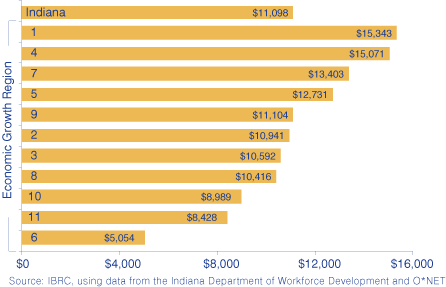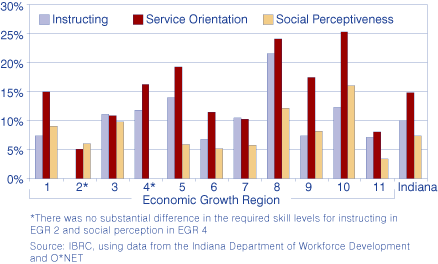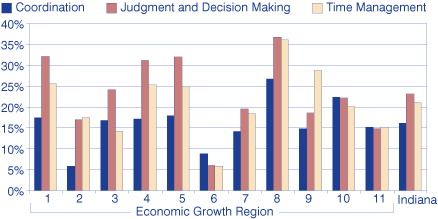Moving "Up One Level:" Preparing for Service and Supervisory Roles through Cross-Functional Skills
Why not start the New Year with a commitment to lifelong learning? This commitment is crucial for building human capital—the skills and learning we acquire in order to pursue economic and life-enriching opportunities. (1) This article is the second of a two-part series that examines the importance of increasing skills for Hoosiers to make job transitions to higher income and improved career prospects. Building on last month's focus on basic skills, this article examines required improvements in key cross-functional skills for service and supervisory roles.
Last month, we discussed the importance of improving basic skills to make job transitions suggested in Indiana's "up one level" reports (2)—transitions that workers can make from "frequently listed jobs" to better-paying occupations without much additional training or experience. (3) Analysis of all 255 job transitions listed in these regional reports revealed that moving "up one level" leads average wages to increase from $21,931 to $32,029 per year. Figure 1 summarizes average wage increases for all 11 economic growth regions. While these job transitions are often modest, they can be important first steps up the career ladder for workers in low-wage jobs. However, moving "up one level" still requires substantial improvement in key basic skills—11 percent for reading comprehension, 17 percent for writing, 19 percent for mathematics, 12 percent for active listening, 16 percent for speaking and 16 percent for critical thinking. Overwhelmingly, this pattern is true across all economic growth regions, and there are very few job transitions in which higher salaries are not accompanied by higher skill requirements. (4)
Figure 1: Average "Up One Level" Skill Salary Increases by Economic Growth Region

The same methodology is now used to examine the higher skill requirements that may be necessary for key cross-functional skills. The occupations listed in the "up one level" reports were analyzed by their skill level scores to measure the extent to which workers may need to improve their skills for successful job transitions. The required skill levels for almost all of these occupations were found in the O*NET database. (5) In the few cases where skill level data were not available, comparable occupations were used.
Developing Cross-Functional Skills
While basic skills are essential for just about any job, cross-functional skills give workers a competitive edge in pursuing high-wage, high-demand occupations and supervisory roles. The need for a broad range of skills is even more important given the major industrial shifts of the U.S. economy—which increasingly demand social skills. Strong growth is expected in professional and business services, as well as the health care and social assistance sector, while smaller growth has been projected in the agricultural and manufacturing sectors. (6) Even in Indiana, the nation's most manufacturing-intensive state, the sectors expected to have the largest growth in jobs are health care, professional and business services, and leisure and hospitality. (7)
This study focuses on the skill level increases of "up one level" job transitions for the six cross-functional skills in highest demand in Indiana through 2014. (8) For the purpose of analysis, these skills have been divided into two groups:
- "Service skills" composed of instructing, service orientation and social perceptiveness skills
- "Supervisory skills" composed of coordination, judgment and decision making, and time management skills
Table 1 describes each skill, along with its corresponding level scale anchors.
Table 1: Description of Skills and Skill Levels
| Skill | Description | Level Scale Anchors | Score |
| Coordination | Adjusting actions in relation to others' actions | Schedule appointments for a medical clinic | 2 |
| Work with others to put a new roof on a house | 4 | ||
| Work as director of a consulting project calling for interaction with multiple subcontractors | 6 | ||
| Instructing | Teaching others how to do something | Instruct a new employee in the use of a time clock | 2 |
| Instruct a co-worker in how to operate a software program | 4 | ||
| Demonstrate surgical procedure to interns in a teaching hospital | 6 | ||
| Judgment and Decision Making | Considering the relative costs and benefits of potential actions to choose the most appropriate one | Decide how scheduling a break will affect work flow | 2 |
| Evaluate a loan application for degree of risk | 4 | ||
| Decide whether a manufacturing company should invest in new robotics technology | 6 | ||
| Service Orientation | Actively looking for ways to help people | Ask customers if they would like cups of coffee | 2 |
| Make flight reservations for customers, using airline reservation system | 4 | ||
| Direct relief agency operations in a disaster area | 6 | ||
| Social Perceptiveness | Being aware of others' reactions and understanding why they react as they do | Notice that customers are angry because they have been waiting too long | 2 |
| Be aware of how a coworker's promotion will affect a work group | 4 | ||
| Counsel depressive patients during a crisis period | 6 | ||
| Time Management | Managing one's own time and the time of others | Keep a monthly calendar of appointments | 2 |
| Allocate the time of subordinates to projects for the coming week | 4 | ||
| Allocate the time of scientists to multiple research projects | 6 | ||
Source: O*NET
Serving Others Can Serve You as Well
Service skills are not only important for high-wage, high-demand jobs but for these initial job transitions as well. This is no surprise since many higher paid jobs that don't require specialized schooling may still require strong interaction skills—whether with co-workers, clients or students. Across Indiana's economic growth regions, higher skill levels are generally expected for all three of these skills (see Figure 2). Moving "up one level" requires increasing instructing skills by 10 percent, service orientation skills by 15 percent, and social perceptiveness skills by 7 percent.
Figure 2: Average "Up One Level" Skill Increases in Instructing, Service Orientation and Social Perceptiveness by Economic Growth Region

This increase in service skills is most pronounced in Region 8 (Bloomington and surrounding counties) where job transitions required high increases in all three skills—22 percent in instructing, 24 percent in service orientation and 12 percent in social perceptiveness. This is expected since all but five of the 25 "up one level" occupations in Region 8's "up one level" report require higher skill levels in two or more of these service skills. On average, service skill increases were lowest in Region 11 (Evansville and surrounding counties) and Region 2 (South Bend and surrounding counties). In fact, Region 2 was the only region whose job transitions did not require improvement in instructing skill. Also noteworthy is the fact that there was no average increase in social perception skill for Region 4 (Lafayette and surrounding counties), even though "up one level" jobs there still required average increases of 12 percent in instructing and 16 percent in service orientation.
Looking more closely at all 255 job transitions listed in the regional "up one level" reports, we find that 70 percent of these job transitions expect higher skill levels for instructing, almost two-thirds in service orientation and social perceptiveness and 44 percent require higher skills in all three of these key service skills. To illustrate this point, consider the job of cashier—one of the most popular occupations on the regional frequently listed job lists. The "up one level" report for Region 11 reports that workers employed as cashiers, with a low annual salary averaging $10,920 per year, can make the transition to pharmacy aide ($19,009 per year) without extensive formal training. While making this transition only requires a small increase in social perceptiveness (3 percent), skill requirements for service orientation and instruction increase 20 percent and 36 percent, respectively. Another example can be found in Region 8 where maids and housekeeping cleaners ($11,700 per year) can make the move to home health aide ($20,333 per year) with short-term on-the-job training. However, this transition would expect them to increase their instruction skills by 30 percent, service orientation skills by 29 percent and social perceptiveness skills by 57 percent. Even in the manufacturing industry, some job transitions require improved service skills such as the suggested move from stock clerk to shipping, receiving and traffic clerk in Region 2 (South Bend and surrounding counties). This transition leads to an average salary increase from $19,718 to $27,258 per year but requires increases in instructing (32 percent), service orientation (23 percent) and social perceptiveness (31 percent).
Only 12 percent of "up one level" job transitions to higher paying jobs require no improvement in any of these service skills—a function of both the job market and the specific nature of certain occupations. One rare case is the suggested move from forklift/industrial truck operator ($21,320 per year) to truck driver ($36,406 per year) in Region 3 (Fort Wayne and surrounding counties). Truck drivers are relatively well paid across Indiana partly due to high demand. However, truck drivers often conduct long-haul solitary trips, involving less interaction with co-workers than forklift operators, perhaps the reason behind their lower service skill requirements.
Improving Skills for More Responsibility
Moving "up one level" often involves earning a supervisory position within the same occupational field or moving into jobs with higher accountability. While such promotion often involves a track record of solid work experience, workers can also expect the need to show improvement in the key supervisory skills of coordination, judgment and decision making, and time management. Figure 3 illustrates this fact, showing that across all regions, job transitions expect much higher skill levels in coordination (16 percent), judgment and decision making (23 percent) and time management (21 percent).
Figure 3: Average "Up One Level" Skill Increases in Coordination, Judgment and Decision Making, and Time Management by Economic Growth Region

Once again, job transitions in Region 8 expect the highest skill increases in all three supervisory skills: 27 percent in coordination, 37 percent in judgment and decision making, and 36 percent in time management. Here, three of the listed "up one level" transitions involve promotion to a supervisory role and virtually all others involve higher responsibility, such as the move from hand packager to delivery truck driver or from retail salesperson to information clerk. Supervisory skill increases were lowest overall in Region 6 (Richmond and surrounding counties) where none of the required skill increases were higher than 10 percent.
Examining all 255 job transitions more closely, we find that three-quarters require higher coordination skills, 72 percent require higher skill in judgment and decision making and time management, and 57 percent require higher skills in all three skills. Region 5 (Indianapolis and surrounding counties) and Region 6 (Richmond and surrounding counties) provide classic examples of transitions to supervisory roles that require appropriate increases in supervisory skills. The move in Region 5 from restaurant cook (with an average salary of $18,720 per year) to supervisor of food preparation and serving workers ($26,656) requires an 11 percent increase in coordination and time management skills, along with a 25 percent increase in the judgment and decision making skill. In Region 6, truck drivers ($40,300) promoted to supervisor of transportation operators ($48,395) are expected to increase their coordination skill by 29 percent, judgment and decision making skill by 32 percent, and time management skill by 27 percent. There are also examples where workers who move to positions of greater responsibility must also improve these supervisory skills. Take industrial workers employed as weighers, measurers, checkers and samplers in Region 1 (northwest Indiana). The "up one level" report suggests that workers in these roles who earn average wages of $25,759 per year can make the move to become production, planning, and expediting clerks ($40,474) with only short-term on-the-job training. However, their required skill levels would need to increase by 22 percent for coordination and more than double for judgment and decision making (up 149 percent) and time management (up 154 percent).
As with service skills, very few "up one level" job transitions (13 percent) require no improvement in any of these three supervisory skills. Typical examples of this rare situation are cases where a worker changes jobs to perform similar tasks in an industry that pays higher wages, such as the move from general maintenance repairer to automotive body repairer, which is suggested in several regions' "up one level" reports. There is even a highly unusual example in Region 9 (Bartholomew and surrounding southeastern counties) in which the "up one level" occupation has substantially higher wages yet notably lower skill level requirements for these supervisory skills. Here, shipping and receiving clerks ($18,720) could make the transition to postal service mail carrier ($43,250 per year)—an occupation with skill requirements that are 17 percent lower for coordination, 41 percent lower for judgment and decision making and 18 percent lower for time management. Workers making this transition may find that they are less accountable for the work of others than when they were clerks while benefiting from higher (often federally determined) wage rates of mail carriers.
From "Up One Level" to High-Wage, High-Demand Jobs
This two-part series stresses the point that to earn more, you must learn more—even for modest "up one level" job transitions. Workers in frequently listed jobs who would like to start climbing the career ladder should consult their region's "up one level" report and consider the need for increasing basic and cross-functional skills. An excellent place for any upwardly mobile Hoosier to start is his or her local WorkOne center. Here, you can plan career strategies, evaluate current skills and receive training resources—often free—to prepare for the next level. (9)
Of course moving "up one level" need only be the first step for workers who would like to move on toward the many high-wage, high-demand jobs available in Indiana. (10) A commitment to lifelong learning includes formal training through college programs and technical institutes and skill-based learning non-degree workshops and seminars. Many of these opportunities are often available at public libraries and local adult education centers. Even getting more active in your community by mentoring adults and children or organizing a neighborhood association can help develop service and supervisory skills that may not be possible at a current job. Rather than letting education end at grade school, today's mobile workers should continue to take advantage of lifelong learning opportunities.
Notes
- Adapted from: Organization for Economic Co-operation and Development (OECD), "Lifelong Learning and Human Capital," Policy Brief, July 2007. Available at www.oecd.org/dataoecd/43/50/38982210.pdf.
- "Up One Level" reports are available for all 11 Economic Growth Regions in the "Publications" section of the Indiana Department of Workforce Development website: www.hoosierdata.in.gov/publookup/default.aspx. This analysis makes use of the reports available for second quarter (April through June) 2007.
- Allison Leeuw and Vicki Seegert, "Putting Feet on Research: Applying Skill Pathway Analysis to Workforce Development," InContext, May 2007: 1-3.
- For more details, see Michael F. Thompson, "Moving 'Up One Level:' Improving Job Prospects by Developing Basic Skills," InContext, December 2007: 7-9.
- The Occupational Information Network (O*NET) determined these required skill levels through surveys of incumbent workers and occupational experts. The O*NET database is a public resource developed by the U.S. Department of Labor, Employment and Training Administration. It is available at
www.onetcenter.org/database.html - Jay M. Berman, "Industry Output and Employment Projections to 2014," November 2005, 128(11): 45-69.
- Jerry N. Conover, "Indiana [Outlook for 2008]" Indiana Business Review, 82(4): 11-13.
- These skills are also called "specialized" skills. The top 12 skill demands are listed in: Michael F. Thompson, "The Demand for Soft Skills: Key Skills for Indiana's Growing Occupations through 2014," InContext, September 2007: 1-2.
- A full list of WorkOne centers and a wide range of other resources for job seekers is available on the Indiana Department of Workforce Development website:
www.in.gov/dwd/2401.htm. - The Indiana Department of Workforce Development has created "Hoosier Hot Jobs" listings for every region across Indiana: www.in.gov/dwd/2564.htm.
Michael F. Thompson, Economic Research Analyst
Indiana Business Research Center, Kelley School of Business, Indiana University
